同济大学:《经济学》课程教学资源(教案讲义)Ch08 Market For Factors of Production
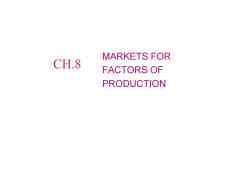
MARKETS FOR CH.8 FACTORS OF PRODUCTION
CH.8 MARKETS FOR FACTORS OF PRODUCTION
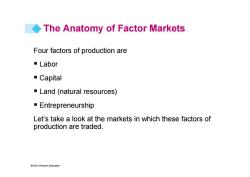
The Anatomy of Factor Markets Four factors of production are Labor Capital Land (natural resources) Entrepreneurship Let's take a look at the markets in which these factors of production are traded. 2012 Pearson Education
© 2012 Pearson Education The Anatomy of Factor Markets Four factors of production are Labor Capital Land (natural resources) Entrepreneurship Let’s take a look at the markets in which these factors of production are traded
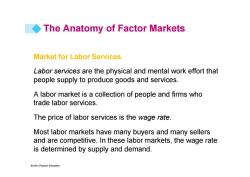
The Anatomy of Factor Markets Market for Labor Services Labor services are the physical and mental work effort that people supply to produce goods and services. A labor market is a collection of people and firms who trade labor services. The price of labor services is the wage rate. Most labor markets have many buyers and many sellers and are competitive.In these labor markets,the wage rate is determined by supply and demand. 2012 Pearson Education
© 2012 Pearson Education Market for Labor Services Labor services are the physical and mental work effort that people supply to produce goods and services. A labor market is a collection of people and firms who trade labor services. The price of labor services is the wage rate. Most labor markets have many buyers and many sellers and are competitive. In these labor markets, the wage rate is determined by supply and demand. The Anatomy of Factor Markets
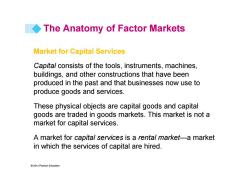
The Anatomy of Factor Markets Market for Capital Services Capita/consists of the tools,instruments,machines, buildings,and other constructions that have been produced in the past and that businesses now use to produce goods and services. These physical objects are capital goods and capital goods are traded in goods markets.This market is not a market for capital services. A market for capital services is a rental market-a market in which the services of capital are hired. 2012 Pearson Education
© 2012 Pearson Education Market for Capital Services Capital consists of the tools, instruments, machines, buildings, and other constructions that have been produced in the past and that businesses now use to produce goods and services. These physical objects are capital goods and capital goods are traded in goods markets. This market is not a market for capital services. A market for capital services is a rental market—a market in which the services of capital are hired. The Anatomy of Factor Markets
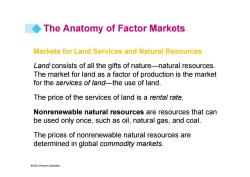
The Anatomy of Factor Markets Markets for Land Services and Natural Resources Land consists of all the gifts of nature-natural resources. The market for land as a factor of production is the market for the services of land-the use of land. The price of the services of land is a rental rate. Nonrenewable natural resources are resources that can be used only once,such as oil,natural gas,and coal. The prices of nonrenewable natural resources are determined in global commodity markets. 2012 Pearson Education
© 2012 Pearson Education Markets for Land Services and Natural Resources Land consists of all the gifts of nature—natural resources. The market for land as a factor of production is the market for the services of land—the use of land. The price of the services of land is a rental rate. Nonrenewable natural resources are resources that can be used only once, such as oil, natural gas, and coal. The prices of nonrenewable natural resources are determined in global commodity markets. The Anatomy of Factor Markets

The Anatomy of Factor Markets Entrepreneurship Entrepreneurship services are not traded in markets. Entrepreneurs receive the profit or bear the loss that results from their business decisions. 2012 Pearson Education
© 2012 Pearson Education Entrepreneurship Entrepreneurship services are not traded in markets. Entrepreneurs receive the profit or bear the loss that results from their business decisions. The Anatomy of Factor Markets
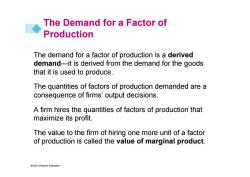
The Demand for a Factor of Production The demand for a factor of production is a derived demand-it is derived from the demand for the goods that it is used to produce. The quantities of factors of production demanded are a consequence of firms'output decisions. A firm hires the quantities of factors of production that maximize its profit. The value to the firm of hiring one more unit of a factor of production is called the value of marginal product. 2012 Pearson Education
© 2012 Pearson Education The demand for a factor of production is a derived demand—it is derived from the demand for the goods that it is used to produce. The quantities of factors of production demanded are a consequence of firms’ output decisions. A firm hires the quantities of factors of production that maximize its profit. The value to the firm of hiring one more unit of a factor of production is called the value of marginal product. The Demand for a Factor of Production
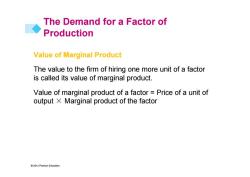
The Demand for a Factor of Production Value of Marginal Product The value to the firm of hiring one more unit of a factor is called its value of marginal product. Value of marginal product of a factor Price of a unit of output X Marginal product of the factor 2012 Pearson Education
© 2012 Pearson Education Value of Marginal Product The value to the firm of hiring one more unit of a factor is called its value of marginal product. Value of marginal product of a factor = Price of a unit of output × Marginal product of the factor The Demand for a Factor of Production
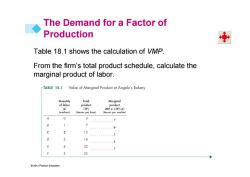
The Demand for a Factor of Production Table 18.1 shows the calculation of VMP. From the firm's total product schedule,calculate the marginal product of labor. -TABLE 18.1 Value of Marginal Product at Angelo's Bakery Quantity Total Marginal of labor product product ) (TP) (workers) (loaves per hour) A 0 0 1 2 13 …5 0 18 …4 22 +3 5 25 2012 Pearson Education
© 2012 Pearson Education Table 18.1 shows the calculation of VMP. From the firm’s total product schedule, calculate the marginal product of labor. The Demand for a Factor of Production
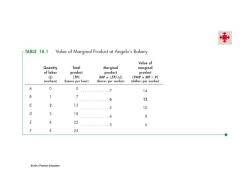
TABLE 18.1 Value of Marginal Product at Angelo's Bakery Value of Quantity Total Marginal marginal of labor product product product ) (TP) MP=△TP/△L) (VMP=MP×P) (workers) (loaves per hour) (loaves per worker) (dollars per worker) A 0 0 7 14 B 7 12 2 13 …5 10 D 3 18 4 E 22 6 5 25 2012 Pearson Education
© 2012 Pearson Education
按次数下载不扣除下载券;
注册用户24小时内重复下载只扣除一次;
顺序:VIP每日次数-->可用次数-->下载券;
- 同济大学:《经济学》课程教学资源(教案讲义)Ch07 General Equilibrium and Economic Efficiency.pdf
- 同济大学:《经济学》课程教学资源(教案讲义)Ch06-2 Imperfect Competition.pdf
- 同济大学:《经济学》课程教学资源(教案讲义)Ch06-1 Analysis of Perfectly Competitive Markets.pdf
- 同济大学:《经济学》课程教学资源(教案讲义)Ch05 Analysis of Cost.pdf
- 同济大学:《经济学》课程教学资源(教案讲义)Ch04 Producer Behavior.pdf
- 同济大学:《经济学》课程教学资源(教案讲义)Ch03 Demand and Consumer Behavior.pdf
- 同济大学:《经济学》课程教学资源(教案讲义)Ch02-2 Applications of Supply and Demand.pdf
- 同济大学:《经济学》课程教学资源(教案讲义)Ch02-1 Supply and Demand.pdf
- 同济大学:《经济学》课程教学资源(教案讲义)Ch01 The Fundamentals of Economics(负责人:李永).pdf
- 同济大学:《经济学》课程教学资源(试卷习题)期终考试试卷(B卷)答案.pdf
- 同济大学:《经济学》课程教学资源(试卷习题)期终考试试卷(B卷)试题.pdf
- 同济大学:《经济学》课程教学资源(试卷习题)期终考试试卷(A卷)答案.pdf
- 同济大学:《经济学》课程教学资源(试卷习题)期终考试试卷(A卷)试题.pdf
- 安徽科技学院:《会计信息系统》课程教学资源(PPT课件)第七章 ERP应用概述.ppt
- 安徽科技学院:《会计信息系统》课程教学资源(PPT课件)第六章 会计信息系统审计.ppt
- 安徽科技学院:《会计信息系统》课程教学资源(PPT课件)第五章 会计信息系统的建设与管理.ppt
- 安徽科技学院:《会计信息系统》课程教学资源(PPT课件)第四章 其他业务核算子系统.ppt
- 安徽科技学院:《会计信息系统》课程教学资源(PPT课件)第三章 报表子系统.ppt
- 安徽科技学院:《会计信息系统》课程教学资源(PPT课件)第二章 账务处理子系统.ppt
- 安徽科技学院:《会计信息系统》课程教学资源(PPT课件)第一章 会计信息系统概述(主讲教师:王伟).ppt
- 同济大学:《经济学》课程教学资源(教案讲义)Ch10 Overview of Macroeconomics.pdf
- 同济大学:《经济学》课程教学资源(教案讲义)Ch09 Externalities and Public Goods.pdf
- 同济大学:《经济学》课程教学资源(教案讲义)Ch11 National Income Accounting.pdf
- 同济大学:《经济学》课程教学资源(教案讲义)Ch12-1 Consumption and Investment.pdf
- 同济大学:《经济学》课程教学资源(教案讲义)Ch12-2 The Determination of Equilibrium Output.pdf
- 同济大学:《经济学》课程教学资源(教案讲义)Ch13 Money Market Equilibrium.pdf
- 同济大学:《经济学》课程教学资源(教案讲义)Ch14 Outputs and Money Market - IS-LM Model.pdf
- 同济大学:《经济学》课程教学资源(教案讲义)Ch15 Aggregate Demand And Supply.pdf
- 同济大学:《经济学》课程教学资源(教案讲义)Ch16 Economic Growth.pdf
- 吉林大学:《中央银行业务管理》课程教学资源(PPT课件)第一章 中央银行制度的形成和发展.ppt
- 吉林大学:《中央银行业务管理》课程教学资源(PPT课件)第七章 中央银行的其他业务.ppt
- 吉林大学:《中央银行业务管理》课程教学资源(PPT课件)第三章 中央银行业务活动的法规原则与资产负债表.ppt
- 吉林大学:《中央银行业务管理》课程教学资源(PPT课件)第九章 中央银行货币政策的目标与工具.ppt
- 吉林大学:《中央银行业务管理》课程教学资源(PPT课件)第二章 中央银行在现代经济体系中的地位与作用.ppt
- 吉林大学:《中央银行业务管理》课程教学资源(PPT课件)第五章 中央银行的资产业务.ppt
- 吉林大学:《中央银行业务管理》课程教学资源(PPT课件)第八章 中央银行货币政策概述.ppt
- 吉林大学:《中央银行业务管理》课程教学资源(PPT课件)第六章 中央银行的支付清算业务.ppt
- 吉林大学:《中央银行业务管理》课程教学资源(PPT课件)第十一章 中央银行的金融监管.ppt
- 吉林大学:《中央银行业务管理》课程教学资源(PPT课件)第十二章 中央银行与外汇管理.ppt
- 吉林大学:《中央银行业务管理》课程教学资源(PPT课件)第十章 货币政策的作用机制.ppt
